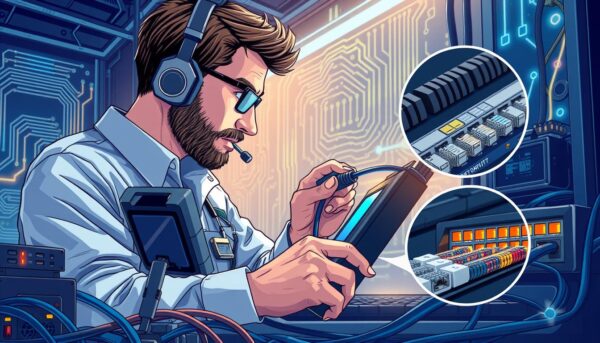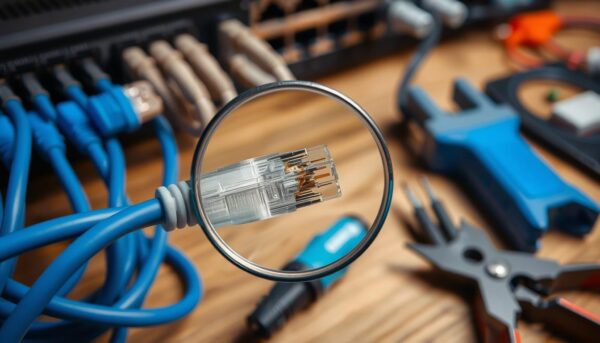✅ Last checked on
Having a stable and fast internet connection is key for work or play online. But, when network cable issues pop up, it can be really frustrating. You might see slow speeds, dropped connections, or even lose internet access altogether. This is when you need to troubleshoot your network cable.
Imagine you’re in the middle of a big project or a video call, and your connection drops. It’s not just annoying; it can really mess up your work. Knowing the signs of cable problems, like losing or slow connections, helps you act fast. Keeping your cables in good shape is key to avoiding these issues and keeping your internet stable.
Network cable problems can come from many sources, like bad cables, wrong installation, or damage. In fact, 98% of connectivity issues are due to the installer, not the cables or hardware. By checking your cables right and using tools like a “Blinky tester,” you can spot and fix problems quickly.
Key Takeaways
- Network cable troubleshooting is essential for a stable and fast internet connection.
- Proper cable maintenance can prevent network cable issues and ensure your internet connection remains stable.
- Common signs of cable connection problems include losing connection, slow connection, and connection restored with a wiggle.
- 98% of the time, issues in network connectivity are attributed to the installer rather than the cables or networking hardware.
- Using tools like a “Blinky tester” can help identify and fix network cable issues quickly.
- Regular visual inspections can help identify up to 40% of cable issues, reducing downtime and increasing productivity.
Understanding Network Cable Issues and Their Impact
Identifying the root cause of network issues is key. LAN cable diagnostics help spot problems with your network cables. These cables often cause connectivity problems. Signs include losing connection, slow speeds, and fixing issues with a wiggle.
Regular checks and replacing old cables can cut down on downtime. Troubleshooting can be tough, but the right tools make it easier. For instance, a coaxial cable tester checks signal strength and finds cable issues.
Common Signs of Cable Connection Problems
- Losing connection
- Slow connection
- Connection restored with a wiggle
Different Types of Network Cables
There are many network cables, like Ethernet, coaxial, and fiber optic. Each has its own needs. Ethernet cables, for example, are used in LANs. It’s important to check for power issues with blinking lights.

The Importance of Proper Cable Maintenance
Keeping cables in good shape is vital. This means cleaning, checking, and replacing damaged ones. Shielded cables protect against interference in noisy areas. Knowing about different cables and how to care for them helps avoid problems and keeps your internet stable.
Essential Network Cable Troubleshooting Steps
To fix ethernet cable problems, start with a clear plan. First, figure out the issue and gather all needed info. Sometimes, just restarting your router or modem can solve the problem. Always check the physical connection of your devices and cables.
Make sure everything is plugged in and turned on. Also, confirm that the Ethernet cable is securely connected to the right ports. A guide for troubleshooting Ethernet cables can help spot common issues. These include damaged cables, wrong connections, or interference from other devices.
Interference from household items like microwaves can affect your connection. It’s wise to test your network cables every six months. This helps catch problems early and keeps your network running smoothly. For more on basic troubleshooting, check out this resource for more on networking.
Here are some important stats for network cable troubleshooting:
- About 85% of network problems come from bad connections or faulty connectors, like RJ45.
- Foot traffic and bad installation can damage cables, affecting up to 30% in busy areas.
- Cable testers can find 95% of cable issues by checking for continuity and pin setup, making diagnosis quick.

By following these steps and using the right tools, you can quickly find and fix cable problems. This reduces downtime and keeps your internet stable. Always choose high-quality cables and manage them well to avoid damage and ensure they work well.
| Issue | Cause | Solution |
|---|---|---|
| Connectivity issues | Improper connections or faulty connectors | Check and replace connectors, ensure proper cable termination |
| Cable damage | Frequent foot traffic, improper installation | Use cable management solutions, avoid high-traffic areas |
| EMI disruptions | Household appliances, cordless phones | Use EMI-resistant cables, keep devices away from cables |
Advanced Diagnostic Tools and Methods
Dealing with network cable issues requires the right tools and methods. CompTIA’s study shows networking skills are crucial for companies. This highlights the need for effective troubleshooting.
To solve network cable problems, use cable testing equipment. Tools like cable testers and signal generators help find signal strength and cable issues. A cable tester ensures network connections are stable, reducing downtime. Learn more about network and cable testing on Fluke Networks blog.
Cable Testing Equipment Overview
Cable testing equipment checks network cable performance and integrity. It finds issues like signal loss and interference. This ensures cables work right and prevents LAN cable diagnostics problems.
Using Software Diagnostics
Software diagnostics help solve network cable issues. These tools analyze network traffic and detect errors. They provide reports on network performance. Visit Network Guides for more on home network health.
Quick Fixes for Common Cable Problems
When you face connectivity issues, it’s key to quickly find the problem with your ethernet cable. Start by figuring out what’s causing the trouble. Often, just restarting your Internet modem or checking each coaxial cable outlet can fix it.
Cleaning the connector or swapping out a broken cable can also solve many problems. It’s important to handle and store cables right to avoid issues. Keep cables straight and avoid bends to keep your internet running smoothly. These steps will help you get a fast and reliable network.
Physical Connection Issues
Physical problems can come from loose or broken cables. Check your cables for damage and make sure they’re well connected. If a cable is damaged, get a new one to keep your connection strong.
Cable Damage Solutions
Cables can get damaged from stress, the environment, or bad installation. Look for damage and replace cables if needed. Good installation and care can stop damage and keep your network working well.
Connector Repairs and Replacements
Fixing or replacing connectors is vital for a stable network. If your connectors are broken, swap them out for new ones. Right installation and upkeep can prevent problems and keep your network fast and reliable.
Conclusion: Best Practices for Network Cable Maintenance
Keeping your network cables in good shape is key for a stable internet connection. By following best practices, you can avoid connectivity problems and stay productive. Regular network cable troubleshooting and maintenance help a lot. Even a small damage to an ethernet cable can hurt your network’s performance.
To keep your cables working well, do regular checks and replace old cables quickly. Good cable management, like labeling and shielding, also helps. These steps ensure your network runs smoothly, giving you fast internet and boosting your work efficiency.